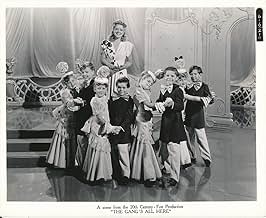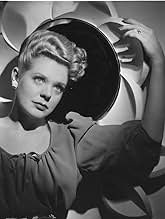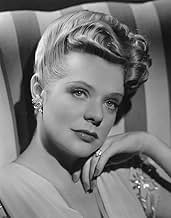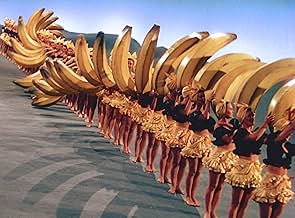CALIFICACIÓN DE IMDb
6.6/10
2.2 k
TU CALIFICACIÓN
Agrega una trama en tu idiomaA soldier falls for a chorus girl and then experiences trouble when he is posted to the Pacific.A soldier falls for a chorus girl and then experiences trouble when he is posted to the Pacific.A soldier falls for a chorus girl and then experiences trouble when he is posted to the Pacific.
- Dirección
- Guionistas
- Elenco
- Nominado a 1 premio Óscar
- 2 premios ganados y 1 nominación en total
Benny Goodman and His Orchestra
- Benny Goodman's Orchestra
- (as Benny Goodman Orchestra)
Don Anderson
- Club New Yorker Patron
- (sin créditos)
Leon Belasco
- Waiter
- (sin créditos)
Brooks Benedict
- Club New Yorker Patron
- (sin créditos)
Lee Bennett
- Club New Yorker Patron
- (sin créditos)
William A. Boardway
- Club New Yorker Patron
- (sin créditos)
Opiniones destacadas
No doubt about it, the movie's a cast of characters collected in someone's goofy heaven—Carmen Miranda, Busby Berkeley, and Edward Everett Horton, all together in one padded cell. Throw in leggy Charlotte Greenwood and froggy Eugene Palette, and there's enough colorful types for ten musicals. Aside from the conventional plot, this 1943 trip to bizzaroland doesn't disappoint for sheer wackiness.
Of course, there's Miranda's infamous arching bananas replete with the recumbent girls, all of which could have sent Dr. Freud into terminal overload. Really, how the carnally obsessed Berkeley managed to stay this side of the censor is still puzzling. And catch that final number with the disembodied heads and Palette croaking out a song. I'm just wondering what Berkeley's dreams were like. They couldn't be any weirder than what's there on the screen.
Then there's the top of Miranda's head sporting more pointy architecture than the Manhattan skyline. And catch her wardrobe—somewhere there's a dozen circus clowns without their costumes. After that, add a few lines of her hilariously fractured English, and she's a whole wonderful show in herself. Too bad her personal life was apparently so unhappy.
Great color photography, along with a soulful Alice Faye. Even the pretty much unknown James Ellison seems a good stand-in for the boys in uniform. No doubt about it, Hollywood knew how to concoct lively and engaging wartime shows. But just as importantly, these concoctions still entertain decades later, even with an inspired lunatic like Busby Berkeley in charge.
Of course, there's Miranda's infamous arching bananas replete with the recumbent girls, all of which could have sent Dr. Freud into terminal overload. Really, how the carnally obsessed Berkeley managed to stay this side of the censor is still puzzling. And catch that final number with the disembodied heads and Palette croaking out a song. I'm just wondering what Berkeley's dreams were like. They couldn't be any weirder than what's there on the screen.
Then there's the top of Miranda's head sporting more pointy architecture than the Manhattan skyline. And catch her wardrobe—somewhere there's a dozen circus clowns without their costumes. After that, add a few lines of her hilariously fractured English, and she's a whole wonderful show in herself. Too bad her personal life was apparently so unhappy.
Great color photography, along with a soulful Alice Faye. Even the pretty much unknown James Ellison seems a good stand-in for the boys in uniform. No doubt about it, Hollywood knew how to concoct lively and engaging wartime shows. But just as importantly, these concoctions still entertain decades later, even with an inspired lunatic like Busby Berkeley in charge.
... from 20th Century Fox and director Busby Berkeley. The meager plot concerns Army sergeant on leave Andy Mason (James Ellison) who falls for nightclub performer Edie Allen (Alice Faye). The only problem is that Andy's already engaged to Vivian Potter (Sheila Ryan). Edie's flamboyant friend and co-worker Dorita (Carmen Miranda) tries to help, to mixed results. Also featuring Eugene Pallette, Edward Everett Horton, Phil Baker, Charlotte Greenwood, Tony De Marco, Dave Willock, Frank Faylen, June Haver and Jeanne Crain in their debuts, and Benny Goodman and His Orchestra.
The plot is naturally secondary to the musical numbers, several of which are bizarre, most notably "The Lady in the Tutti Frutti Hat", featuring chorus girls running around with giant bananas. Berkeley's camera moves around, under and above the action, shattering the pretense that these numbers are designed for a nightclub or theatrical audience, taking them strictly into the realm of cinema. The costumes are also eye-popping, even those worn in the non-musical scenes, and Miranda wears an assortment of outlandish hats. This marked the end of Alice Faye's star period. She had a cameo in the following year's Four Jills in a Jeep, and then a non-musical part in 1945's Fallen Angel, before entering into screen retirement for 17 years. The movie earned an Oscar nomination for Best Color Art Direction.
The plot is naturally secondary to the musical numbers, several of which are bizarre, most notably "The Lady in the Tutti Frutti Hat", featuring chorus girls running around with giant bananas. Berkeley's camera moves around, under and above the action, shattering the pretense that these numbers are designed for a nightclub or theatrical audience, taking them strictly into the realm of cinema. The costumes are also eye-popping, even those worn in the non-musical scenes, and Miranda wears an assortment of outlandish hats. This marked the end of Alice Faye's star period. She had a cameo in the following year's Four Jills in a Jeep, and then a non-musical part in 1945's Fallen Angel, before entering into screen retirement for 17 years. The movie earned an Oscar nomination for Best Color Art Direction.
It was called "The Girls He Left Behind", when first released in Britain in 1944. In this movie I think Busby Berkeley reached the pinnacle. It was his finest effort. Carmen Miranda, wearing that tutti frutty hat was a mouth-watering revelation; along with her ability to murder the English language. Roly poly Eugene Palette, trying to get the worrisome Edward Everett Horton's mind off his wife. Handing their hats to the hat-check girl, who was the lovely June Haver. (If you blinked you would have missed her). Alice Faye? A dream in Technicolour. James Ellison in the leading romantic role. Where was John Payne? He was the usual romantic lead in these Twentieth Century Fox musical capers of the early nineteen-forties.
Weak plot? Who the hell really cared! The Benny Goodman Orchestra; those songs, and the rich Technicolour, plus the Lanky Charlotte Greenwood, blindly reaching for the telephone and answering with the cat instead, brightened this teen-aged English boy's life in those wartime years of long ago. I have watched it on television more than once. The big question though. Why oh why, has it not been released on video or, better still, DVD? Can anyone explain?
Weak plot? Who the hell really cared! The Benny Goodman Orchestra; those songs, and the rich Technicolour, plus the Lanky Charlotte Greenwood, blindly reaching for the telephone and answering with the cat instead, brightened this teen-aged English boy's life in those wartime years of long ago. I have watched it on television more than once. The big question though. Why oh why, has it not been released on video or, better still, DVD? Can anyone explain?
Something between a fever-dream and a screwball comedy, THE GANG'S ALL HERE is the Fox Musical at its most extravagant. With everthing from Charlotte Greenwood doing her trademarked high-kick routine to Carmen Miranda in a ten-story banana headdress, there's never a dull moment (that might let you concentrate too closely on the plot, which can most charitably be described as serviceable). The picture is a carnival of character bits, ridiculous shtick, and mind-boggling transitions. Edward Everett Horton gets covered with Carmen's lipstick and claims it's ketchup -- "Yes, and from a Brazilian tomato!" ripostes his wife (Greenwood, who really is terrific here). Eugene Pallette growls "Don't be a square from Delaware!" when he wants his pal Horton to get hep and join in the latest dance sensation. A New York nightclub has a stage large enough for what looks like all of a tropical island (for Carmen's immortal "Lady in the Tutti-Frutti Hat" number, truly a Freudian nightmare), and a number set in a Westchester backyard features more trick fountains than two Esther Williams epics.
In the end, it all just stops, with a 30-second plot resolution ("oh, yes, didn't I tell you? He's loved you all along!" or some such) in order to make room for the finale, the most dizzying number yet: a paean to the polka-dot (featuring Alice Faye's most effortful emoting ever on the line "...But the Polka Dot...Lives...On!") that segues into a ballet featuring neon hoops, vast rolling dots, kaleidoscopic trick photography, and, finally, an endearingly primitive blue-curtain effect that shows the heads of all the principals (and hundreds of chorus girls) bouncing along to a reprise of the hit ballad "A Journey to a Star." Well, THE GANG'S ALL HERE may not be quite that, but it's certainly a journey into a different era in filmmaking.
In the end, it all just stops, with a 30-second plot resolution ("oh, yes, didn't I tell you? He's loved you all along!" or some such) in order to make room for the finale, the most dizzying number yet: a paean to the polka-dot (featuring Alice Faye's most effortful emoting ever on the line "...But the Polka Dot...Lives...On!") that segues into a ballet featuring neon hoops, vast rolling dots, kaleidoscopic trick photography, and, finally, an endearingly primitive blue-curtain effect that shows the heads of all the principals (and hundreds of chorus girls) bouncing along to a reprise of the hit ballad "A Journey to a Star." Well, THE GANG'S ALL HERE may not be quite that, but it's certainly a journey into a different era in filmmaking.
What the other comments thus far seem to say is that this is a fun movie without much story. It has Carmen Miranda and her Tutti Fruity hat and that makes up for a weak, sewn together plot. What they seem to have overlooked is that this film wasn't made in the thirties or fifties, it was produced in the middle of World War II. Yes it has some great Busby Berkeley numbers, but its historical and ideological implications are profound as well.
This was a film whose plot was never meant to suture an audience into a conventional story, it was meant to reassert American ideology during a remarkably difficult time. There are comical references to the "Good Neighbor Policy"- all but forgotten outside history classes. Ultimately, the film endorses American hegemony during the period through the friendly inclusion and references to South and Latin American imports such as coffee and Carmen Miranda. It also reminds the home front that its primary duty is to support the men on the front lines; women should make and keep promises of fidelity, and those who can should contribute money through war bonds, those who can't should contribute sweat equity. THE GANG'S ALL HERE is ultimately a war movie, but it is a movie which assumes American military superiority a priori; rather, it asserts and enforces the notion of a superior American will and character. Perhaps the plot seems dated, but historically and ideologically it is perfectly balanced and constructed.
This was a film whose plot was never meant to suture an audience into a conventional story, it was meant to reassert American ideology during a remarkably difficult time. There are comical references to the "Good Neighbor Policy"- all but forgotten outside history classes. Ultimately, the film endorses American hegemony during the period through the friendly inclusion and references to South and Latin American imports such as coffee and Carmen Miranda. It also reminds the home front that its primary duty is to support the men on the front lines; women should make and keep promises of fidelity, and those who can should contribute money through war bonds, those who can't should contribute sweat equity. THE GANG'S ALL HERE is ultimately a war movie, but it is a movie which assumes American military superiority a priori; rather, it asserts and enforces the notion of a superior American will and character. Perhaps the plot seems dated, but historically and ideologically it is perfectly balanced and constructed.
¿Sabías que…?
- TriviaThe production number "The Lady In The Tutti-Frutti Hat" ran into problems with the censors. The Hayes office at first considered the way the gigantic bananas were held in front of the dancers as being too "phallic". The problem was resolved by having the dancers hold the bananas at waist level rather than at hip level.
- ErroresIncorrectly regarded as goof: As the passengers disembark the ship within the first 3 minutes of the film, a series of mechanical-looking large shadows can be easily seen moving across the painted backdrop of buildings intended to be far in the distance. This is actually a stage set of a musical production, thus not filmed as a real scene.
- Citas
Phil Baker: Oh, Dorita, you remember Mr. Potter and Mr. Mason.
Dorita: Ah! I remember Mr. Potty. You are here to kick up some more heels, huh?
Peyton Potter: No!
Phil Baker: Mr. Potter wants you to come to his house this weekend.
Dorita: Ah-ah-ah, you naughty boy. You are what they call a fast-work man, yes?
- ConexionesEdited into Myra Breckinridge (1970)
- Bandas sonorasHail! Hail! The Gang's All Here!
(uncredited)
Music by Theodore Morse and Arthur Sullivan
Lyrics by Dolly Morse (as D.A. Esrom)
Sung by a chorus during the opening credits
Selecciones populares
Inicia sesión para calificar y agrega a la lista de videos para obtener recomendaciones personalizadas
- How long is The Gang's All Here?Con tecnología de Alexa
Detalles
- Fecha de lanzamiento
- País de origen
- Idiomas
- También se conoce como
- The Gang's All Here
- Locaciones de filmación
- Productora
- Ver más créditos de la compañía en IMDbPro
- Tiempo de ejecución1 hora 43 minutos
- Color
- Relación de aspecto
- 1.33 : 1
Contribuir a esta página
Sugiere una edición o agrega el contenido que falta

Principales brechas de datos
By what name was Entre la rubia y la morena (1943) officially released in India in English?
Responda





































